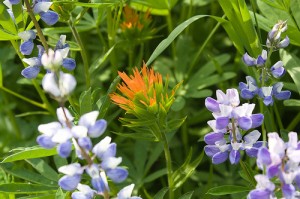Before dawn on October 3, 1932, in the small Columbia River town of Bingen, Washington, an 82-year-old man walked to the depot to catch the morning train to Portland. Under circumstances that remain unclear, the arriving train struck him down, killing him almost instantly.
The man had lived in town for more than half a century, and he was known as a shy, somewhat eccentric bachelor who loved flowers. Not until the Portland Oregonian published his obituary—under the headline “Famed Botanist Killed“—did his neighbors realize that he had an international reputation.
Wilhelm Suksdorf grew up in an isolated German immigrant community in Iowa, where from an early age he was fascinated by plants. Oregon botanist Rhoda Love writes that when Suksdorf was in his early 20s, his older brothers moved to the north shore of the Columbia River in Washington state. After a miserable couple of years at the University of California — Suksdorf had had little formal schooling, and was always more comfortable in German than English — he moved north to join his brothers.
 Suksdorf found that his treasured plant manual, written by Harvard professor and preeminent botanist Asa Gray, wasn’t nearly as useful in the Northwest as it had been in Iowa, so he began to send Gray some specimens of his own. Gray, who relied on amateur collectors in faraway places, was encouraging. Soon Suksdorf and Gray were in regular correspondence, and Suksdorf was sending specimens to Harvard from all over the Northwest. By 1879, Gray had even named a new genus and species for his young protege: Suksdorfia violacea or violet Suksdorfia, a pretty purple native that Suksdorf collected in the Columbia River Gorge.
Suksdorf found that his treasured plant manual, written by Harvard professor and preeminent botanist Asa Gray, wasn’t nearly as useful in the Northwest as it had been in Iowa, so he began to send Gray some specimens of his own. Gray, who relied on amateur collectors in faraway places, was encouraging. Soon Suksdorf and Gray were in regular correspondence, and Suksdorf was sending specimens to Harvard from all over the Northwest. By 1879, Gray had even named a new genus and species for his young protege: Suksdorfia violacea or violet Suksdorfia, a pretty purple native that Suksdorf collected in the Columbia River Gorge.
Gray suggested that Suksdorf concentrate his efforts around Mount Adams, a volcanic peak not far from Bingen, and Suksdorf followed his advice with enthusiasm, sometimes spending weeks in the backcountry. In 1886, Gray finally convinced Suksdorf to come to Cambridge to work as his herbarium assistant, but Gray died just over a year later, and Suksdorf soon returned to Bingen—with, one imagines, at least some sense of relief. Except for a few short trips, he stayed in the area for the rest of his life.
Naturalists tend to be either “splitters” or “lumpers,” with splitters liking to declare new species and lumpers liking to consolidate them. Suksdorf, like his mentor Asa Gray, was a splitter—he once proposed dividing a single species into more than 100—and not all of the species he described have survived the scrutiny of later generations. But many have, and 150,000 of the specimens he so meticulously preserved are now part of herbaria collections around the world.
Suksdorf’s house still stands in Bingen, and local plant enthusiasts are now interested in preserving it. Suksdorf might appreciate that his legacy is much like his life: long-lasting, rich with knowledge, and very, very quiet.
Top photo courtesy of Flickr user Vicki Gibson. (I know, they’re Texas bluebonnets—but you get the idea.)
Photo of Suksdorf’s Paintbrush, Castilleja suksdorfii, flanked by lupines courtesy of Flickr user OpalMirror.
Thanks to Keith Karoly for sharing Suksdorf’s story over dinner.

One thought on “The Botanist Nobody Knew”
Comments are closed.